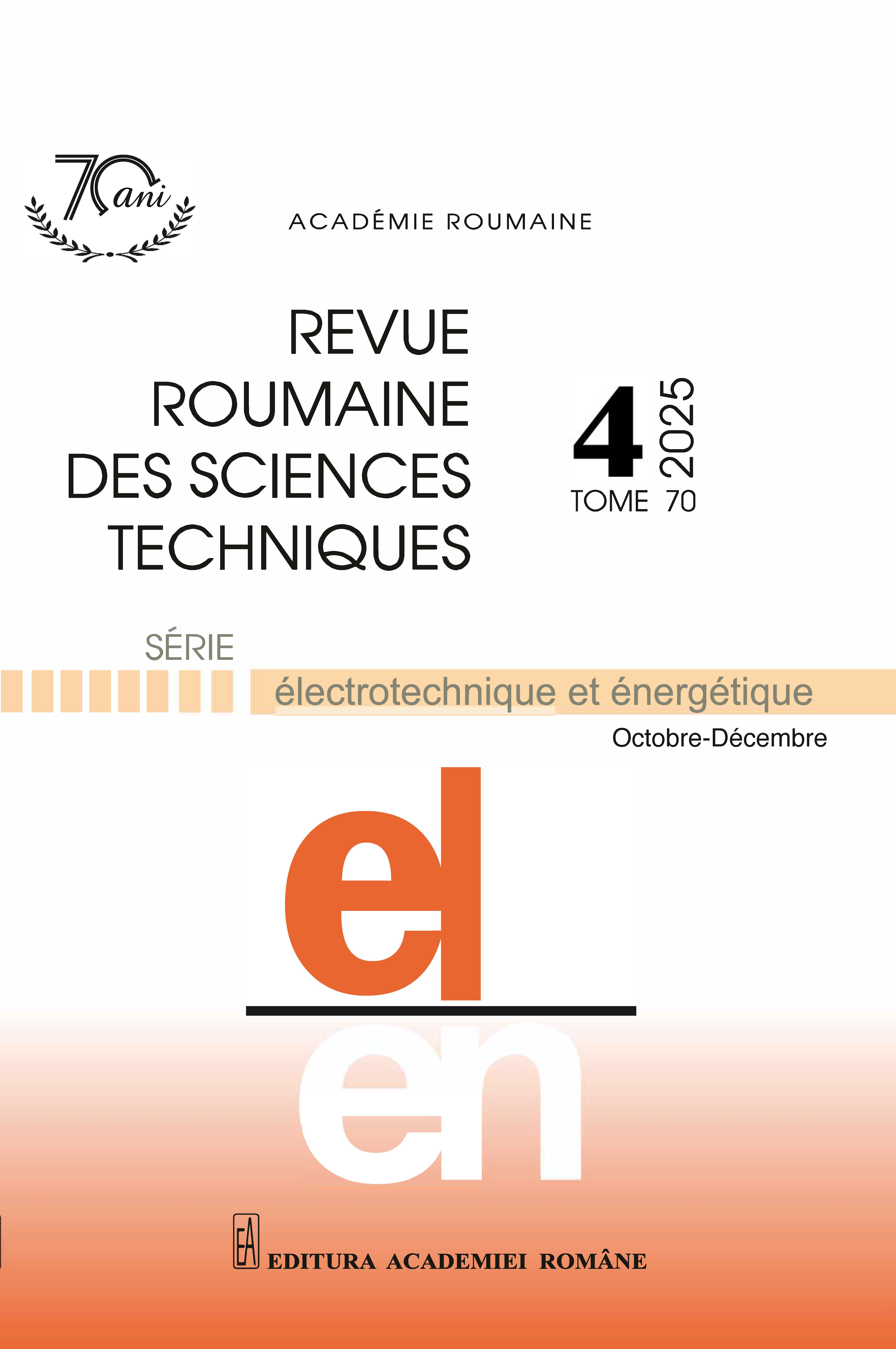ELECTROPERMEABILIZATION FOR ORGANIC MATERIAL – NUMERICAL MODELING
DOI:
https://doi.org/10.59277/RRST-EE.2025.4.28Keywords:
Electropermeabilization (EP), Electric field, Electric conductivity, Heat transfer, Finite element method (FEM)Abstract
Electroporation, also known as electropermeabilization (EP), occurs when a cell's transmembrane potential exceeds a critical threshold under the influence of an electric field, corresponding to a limit value of the electric field intensity. EP depends on the distribution of the electric field, which in turn depends on and, here, determines the material's electrical properties. Some critical electric field strengths act as a “switch” for the EP, which is, to some extent, reversible. This paper aims, through numerical experiments, to unveil the effects of the electric field on the poration of an organic substance (lavender) and the thermal stability of the EP cell. The substance is assumed to be a continuous medium with electric-field-dependent material properties.
References
(1) T. Kotnik, W. Frey, M. Sack, S. Haberl Meglič, M. Peterka, D. Miklavčič, Electroporation-based applications in biotechnology, Trends Biotechnol., 33, 8, pp. 480–488 (Aug. 2015).
(2) E. Demir, S. Tappi, K. Dymek, P. Rocculi, F. Gómez Galindo, Reversible electroporation caused by pulsed electric field – Opportunities and challenges for the food sector, Trends Food Sci. Technol., 139, p. 104120 (2023).
(3) K. A. DeBruin, W. Krassowska, Modeling electroporation in a single cell: Effects of field strength and rest potential, Biophys. J., 77, 3, pp. 1213–1224 (Sep. 1999).
(4) T. Kotnik, G. Pucihar, M. Rebersek, D. Miklavčič, L.M. Mir, Role of pulse shape in cell membrane electropermeabilization, Biochim. Biophys. Acta, 1614, 2, pp. 193–200 (Aug. 2003).
(5) C.I. Mocanu, Electromagnetic Field Theory, (in Romanian) E.D.P., Bucharest (1982).
(6) T.T.N. Vu, G. Teyssedre, S. Le Roy, C. Laurent, Maxwell–Wagner effect in multi-layered dielectrics: interfacial charge measurement and modelling, Technologies, 5, 27 (2017).
(7) H.P. Schwan, Electrical properties of tissue and cell suspensions, Advances in biological and medical physics, 5, pp. 147-209 (1957).
(8) K.R. Foster, H.P. Schwan, Dielectric properties of tissues and biological materials: a critical review, Critical reviews in biomedical engineering, 17, 1, pp. 25-104 (1989).
(9) L. Bao, W. Shang, Dielectric Properties of Biological Tissues: A Review. Sensors, 18, 5, 1433, (2018).
(10) K. Dymek, P. Dejmek, F. Gomez Galindo, Influence of pulsed electric field protocols on the reversible permeabilization of rucola leaves, Food and Bioprocess Technology, 7, 3, pp. 761–773 (2014).
(11) E. Vorobiev, N. Lebovka, Pulsed-Electric-Fields-Induced Effects in Plant Tissues: Fundamental Aspects and Perspectives of Applications, in Electrotechnologies for Extraction from Food Plants and Biomaterials, Springer, New York, pp. 39–81, NY(2008).
(12) J. Kulbacka, L.M. Frey, M. Kotulska, Electroporation in biological membranes: Theory and applications, in Advances in Biomembranes and Lipid Self-Assembly, 29, pp. 65–110, Academic Press (2019).
(13) B. Gabriel, J. Teissié, Direct observation in the millisecond time range of fluorescent molecule asymmetrical interaction with the electropermeabilized cell membrane, Biophysical Journal, 73, 5, pp. 2630–2637 (1997).
(14) K. Dymek, P. Dejmek, F. Gomez Galindo, Influence of pulsed electric field protocols on the reversible permeabilization of rucola leaves, Food and Bioprocess Technology, 7, 3, 761–773 (2014).
(15) T.T.N. Vu, G. Teyssedre, S. Le Roy, C. Laurent, Maxwell–Wagner effect in multi-layered dielectrics: interfacial charge measurement and modelling, Technologies, 5, 27 (2017).
(16) A. Çınar , K. Ateş , L.N.Ö. Polat , S. Elmasulu , I.K. Oğuz , O. Çınar, Ş. Özen, Adulteration control of lavender essential oil by using its electrical properties in the low-frequency range, Measurement Science Review, 25, 3, pp. 141–147 (2025).
(17) K. Kurata, M. Matsushita, T. Yoshii, T. Fukunaga, H. Takamatsu, Effect of irreversible electroporation on three-dimensional cell culture model, Proc. Annu. Int. Conf. IEEE Eng. Med. Biol. Soc. (EMBC), San Diego, CA, USA, pp. 179–182 (2012).
(18) ***Comsol a.b., www.comsol.com.
(19) F. Guo, X. Nie, J. Hong, Y. Zhang, J. Sun, Influence of Joule heating during single-cell electroporation simulation under IRE and H-FIRE pulses, Materials Today Communications, 33, p. 104358 (2023).
(20) S. Najafian, The effect of time and temperature on the shelf life of essential oils of Lavandula officinalis, J. of Essential Oil Research, 28, 5, pp. 413–420 (2016).
(21) K. Kurata, M. Matsushita, T. Yoshii, T. Fukunaga, H. Takamatsu, Effect of irreversible electroporation on three-dimensional cell culture model, in Proc. Annu. Int. Conf. IEEE Eng. Med. Biol. Soc. (EMBC), San Diego, CA, USA, pp. 179–182 (2012).
Downloads
Published
Issue
Section
License
Copyright (c) 2025 REVUE ROUMAINE DES SCIENCES TECHNIQUES — SÉRIE ÉLECTROTECHNIQUE ET ÉNERGÉTIQUE

This work is licensed under a Creative Commons Attribution-NonCommercial-NoDerivatives 4.0 International License.


